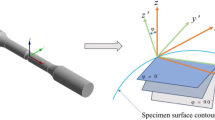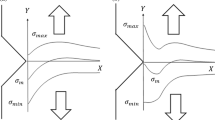Abstract
Considering the situation that fatigue life prediction of notched component is an indispensable part in the process of design in engineering, it is necessary to find some ways to solve such problems effectively. The stress and strain state of notched specimen is more complex, compared with smooth specimen. As a result, some researchers take advantage of the finite element method to analyze the mechanical properties of these kind of specimens, they can get the stress and strain state at the dangerous point directly instead of using theoretical methods. At the same time, the equation of shear stress is fitted by analyzing stress distribution of the section of notch root. The integral of shear stress in the section is equal to the external load, and the true stress value of notch root is derived. Then, the fatigue damage evolution equation of notched specimens under torsional load is proposed based on the closed-form solution in this paper. Meanwhile, the nonlinear fatigue life prediction model of notched specimens under the torsional load is given by using the damage mechanics theory. The proposed model is validated by experimental data (30CrMnSiNi2A steel and 45# steel). The results show that the predicted life is not only close to the experimental results, but also tends to be safe. The fatigue life of notched specimen is predicted by using notch geometric parameters and material constants. The model has more concise calculation process, avoids complicated fatigue tests, and facilitates engineering application.
Similar content being viewed by others
References
PETRUCCI G, ZUCCARELLO B. Fatigue life prediction under wide band random loading [J]. Fatigue & Fracture of Engineering Materials & Structures, 2004, 27(12): 1183–1195.
YOUSEFI F, WITT M, ZENNER H. Fatigue strength of welded joints under multiaxial loading: Experiments and calculations [J]. Fatigue & Fracture of Engineering Materials & Structures, 2001, 24(5): 339–355.
BERETTA S, FOLETTI S, VALIULLIN K. Fatigue strength for small shallow defects/cracks in torsion [J]. International Journal of Fatigue, 2011, 33(3): 287–299.
SAVRUK M P, KAZBERUK A. Stress concentration near sharp and rounded V-notches in orthotropic and quasi-orthotropic bodies [J]. Theoretical and Applied Fracture Mechanics, 2016, 84: 166–176.
FAJDIGA G, SRAML M. Fatigue crack initiation and propagation under cyclic contact loading [J]. Engineering Fracture Mechanics, 2009, 76(9): 1320–1335.
HIRAKATA H, TAKAHASHI Y, VAN TRUONG D, et al. Role of plasticity on interface crack initiation from a free edge and propagation in a nano-component [J]. International Journal of Fracture, 2007, 145(4): 261–271.
TAYLOR D. A mechanistic approach to critical-distance methods in notch fatigue [J]. Fatigue & Fracture of Engineering Materials & Structures, 2001, 24(4): 215–224.
BENEDETTI M, FONTANARI V, SANTUS C, et al. Notch fatigue behaviour of shot peened high-strength aluminium alloys: Experiments and predictions using a critical distance method [J]. International Journal of Fatigue, 2010, 32(10): 1600–1611.
SKORUPA M. Load interaction effects during fatigue crack growth under variable amplitude loading: A literature review. Part II: Qualitative interpretation [J]. Fatigue & Fracture of Engineering Materials & Structures, 1999, 22(10): 905–926.
SAMIR A, SIMON A, SCHOLZ A, et al. Servicetype creep-fatigue experiments with cruciform specimens and modelling of deformation [J]. International Journal of Fatigue, 2006, 28(5/6): 643–651.
BRIGHENTI R, CARPINTERI A. A notch multiaxial-fatigue approach based on damage mechanics [J]. International Journal of Fatigue, 2012, 39: 122–133.
MARCINIAK Z, ROZUMEK D, MACHA E. Verification of fatigue critical plane position according to variance and damage accumulation methods under multiaxial loading [J]. International Journal of Fatigue, 2014, 58: 84–93.
BARBU L G, OLLER S, MARTINEZ X, et al. High cycle fatigue simulation: A new stepwise load-advancing strategy [J]. Engineering Structures, 2015, 97: 118–129.
EFTIS J, NEMES J A. Evolution equation for the void volume growth rate in a viscoplastic-damage constitutive model [J]. International Journal of Plasticity, 1991, 7(4): 275–293.
ZHOU J P, LU Y C. A damage evolution equation of particle-filled composite materials [J]. Engineering Fracture Mechanics, 1991, 40(3): 499–506.
JUN Z, XING Z. The asymptotic study of fatigue crack growth based on damage mechanics [J]. Engineering Fracture Mechanics, 1995, 50(1): 131–141.
CHOW C L, WEI Y. A model of continuum damage mechanics for fatigue failure [J]. International Journal of Fracture, 1991, 50(4): 301–316.
GLINKA G, SHEN G, PLUMTREE A. A multiaxial fatigue strain energy density parameter related to the critical fracture plane [J]. Fatigue & Fracture of Engineering Materials & Structures, 1995, 18(1): 37–46.
KACHANOV L M. Rupture time under creep conditions [J]. International Journal of Fracture, 1999, 97(1/2/3/4): 11–18.
QIU J, SETH B B, LIANG S Y, et al. Damage mechanics approach for bearing lifetime prognostics [J]. Mechanical Systems and Signal Processing, 2002, 16(5): 817–829.
RABOTNOV Y N. On the equations of state for creep [J]. Proceedings of the Institution of Mechanical Engineers, Conference Proceeding, 1963, 178(1): 117–122.
LEMAITRE J. A continuous damage mechanics model for ductile fracture [J]. Journal of Engineering Materials & Technology, 1985, 107(1): 83–89.
LEMAITRE J, DESMORAT R. Engineering damage mechanics [M]. Berlin: Springer, 2005.
LEMAITRE J, PLUMTREE A. Application of damage concepts to predict creep-fatigue failures [J]. Journal of Engineering Materials and Technology, 1979, 101(3): 284–292.
CHABOCHE J L. A review of some plasticity and viscoplasticity constitutive theories [J]. International Journal of Plasticity, 2008, 24(10): 1642–1693.
CHEN J, DING Z, YIN Z, et al. Study on low-cycle fatigue experiments and life prediction of single crystal nickel-based superalloys under asymmetrical cyclic load [J]. Acta Mechanica Solida Sinica, 2007, 28(2): 115–120 (in Chinese).
LIU J H, WEI Y B, YAN C F, et al. Method for predicting crack initiation life of notched specimen based on damage mechanics [J]. Journal of Shanghai Jiao Tong University (Science), 2018, 23(2): 286–290.
YIP M C, JEN Y M. Notch effect on two-level cumulative low-cycle fatigue life under different biaxial loading mode sequences [J]. Fatigue & Fracture of Engineering Materials & Structures, 1995, 18(11): 1323–1332.
HU Y D, HU Z Z, CAO S Z. Theoretical study on Manson-Coffin equation for physically short cracks and lifetime prediction [J]. Science China Technological Sciences, 2012, 55(1): 34–42.
HUANG X Z. Experimental study on the effect of mean shear stress on torsional fatigue strength of 30CrMnSiNi2A material [J]. Mechanical Strength, 1987(1): 51–56 (in Chinese).
YUAN Y Z, ZHAO M Y, ZHANG C P. Axial fatigue and torsion fatigue behavior on V-notch of 45 steel [J]. Transactions of Materials and Heat Treatment, 2014, 35(10): 103–107 (in Chinese).
Author information
Authors and Affiliations
Corresponding author
Additional information
Foundation item: the National Natural Science Foundation of China (No. 51605212), the Natural Science Foundation of Gansu Province (No. 17JR5RA1220), and the Hongliu Youth Fund of Lanzhou Uinversity of Technology
Rights and permissions
About this article
Cite this article
Liu, J., Lü, X., Wei, Y. et al. Notched Component Fatigue Life Prediction in Torsional Loading. J. Shanghai Jiaotong Univ. (Sci.) 26, 813–818 (2021). https://doi.org/10.1007/s12204-020-2247-3
Received:
Accepted:
Published:
Issue Date:
DOI: https://doi.org/10.1007/s12204-020-2247-3




